Inside the Nintendo Museum: a joyful celebration of machines, magic and the art of play
Link to the past.
To visit the Nintendo Museum in the leafy suburbs of Uji City's Oguracho district, about a half hour train ride from their headquarters in Kyoto, is to journey back to simpler and happier times. Most museums, of course, strive to dig up the past and present it in such a way that contemporary audiences can easily digest it, but it's rare to feel this transformation take place quite so literally. As you leave the bustling modernity of Kyoto Station behind, concrete gives way to fields, mountains and farms, transporting you to the kind of rural idyll you might remember from games like Attack of the Friday Monsters or Famicom Detective Club.
The streets are quiet when we visit the Museum ahead of its opening on 2nd October, and the town itself doesn't seem prepared for the carriagefuls of visitors that will no doubt be spilling out of the station's trio of ticket gates come next month. But Nintendo has long had a presence here, as the Museum is built on the site of Nintendo's former hanafuda manufacturing plant, opened in 1969. Indeed, the focus of its three buildings now lies as much with Nintendo's pre-Mario days of making playing cards, as it does with the video games it makes today.
Indeed, one of the last things you see as you leave the museum is a framed work of calligraphy by Chin-Seki Tsumura, who donated the piece to Nintendo when its head office was built in 1971. Its bold brushstrokes depict the words "Ninten" - the famous phrase that means "leaving luck to heaven", which is widely believed to be what Nintendo's name represents.
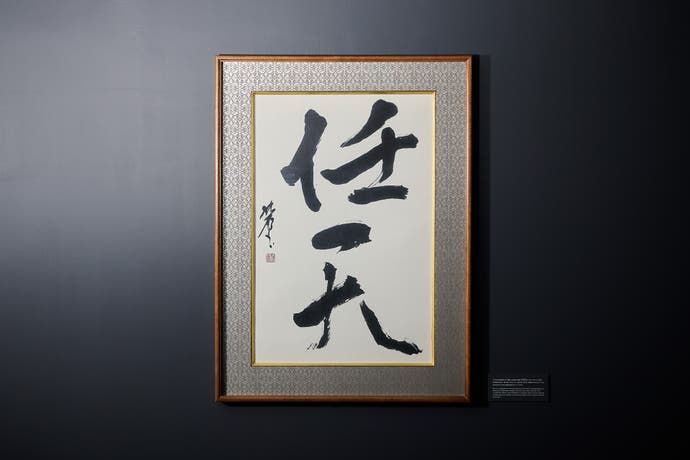
It's one of only two objects in the whole museum that has an accompanying plaque beside it, detailing the artist and meaning of the phrase so you know what you're looking at and what its significance is. Admittedly, this kind of hands-off approach and almost outright refusal to define and contextualise its own history is one that both makes and breaks the Nintendo Museum as an experience (more on that in a sec). But I do think there is something oddly fitting about the fact that even this rare morsel of information still manages to fire the imagination in a way that resists being tied down by the dry and heavy boot of factual absolutes.
As Nintendo buffs may well already know, the exact origin of Nintendo's name is still unknown, and the plaque states as much, leaving visitors to wonder what other possibilities might exist as they peruse the spacious aisles of its hardware-themed gift shop and agonise over whether to spend upwards of £60's worth of Yen on a giant, plush Wii Remote (SNES, Famicom and N64 controller plushes are also available).
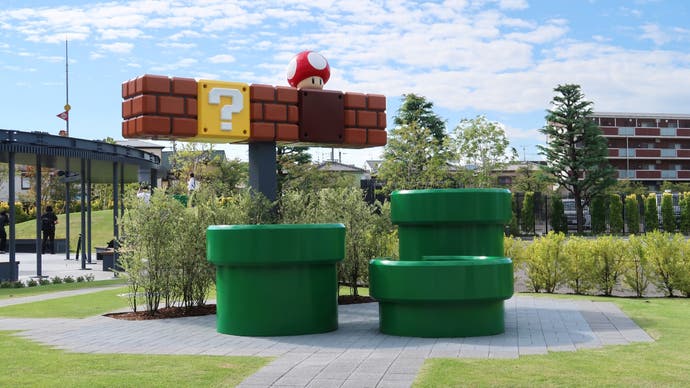
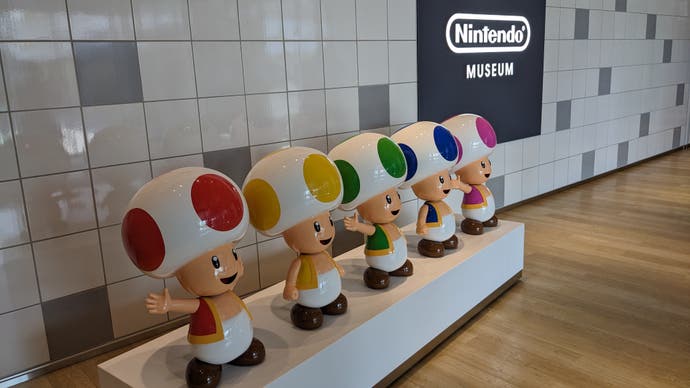
Forging your own connections with Nintendo's vast history of work is very much the theme of this museum, and as visitors funnel their way past the Game Boy-themed lockers and umbrella stands (possibly stopping to grab a quick drink from the mouth of the Kirby vending machine in the process), finish posing for photos in the large green warp pipes outside, and tear themselves away from the five Toads in the brightly-lit entrance that break out into a harmonious (if slightly cursed) chorus when you waggle their large and bulbous heads, they'll be told as much on a large TV screen as they queue to ascend into the museum's first major exhibit: the Product Floor.
Here, visitors scan their personally-named entry cards (printed onsite at the security gate from their ticket's QR code) and pool into a dimly-lit room awash with the sound of Nintendo's console start-up sounds, with machine silhouettes on the wall lighting up in response to blow the dust off any half-recalled memories. Staff then usher you up a dark escalator, the jet-black walls punctuated with large, floating pixel squares like a blocky starscape, until you emerge into the bright, gleaming lights of the exhibit, right in the middle of a 360-degree celebration of Nintendo's history.
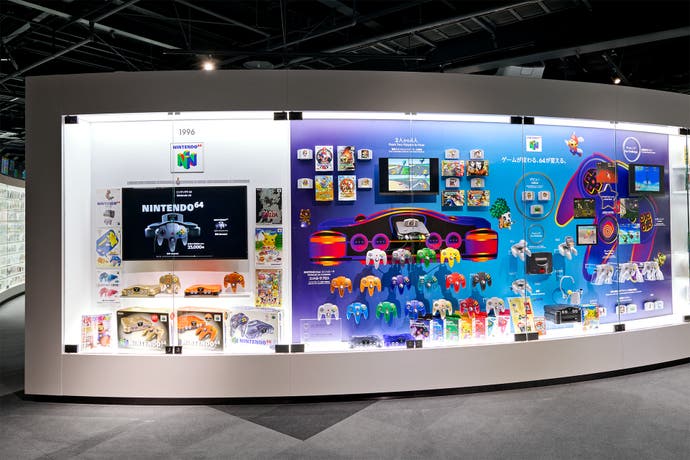
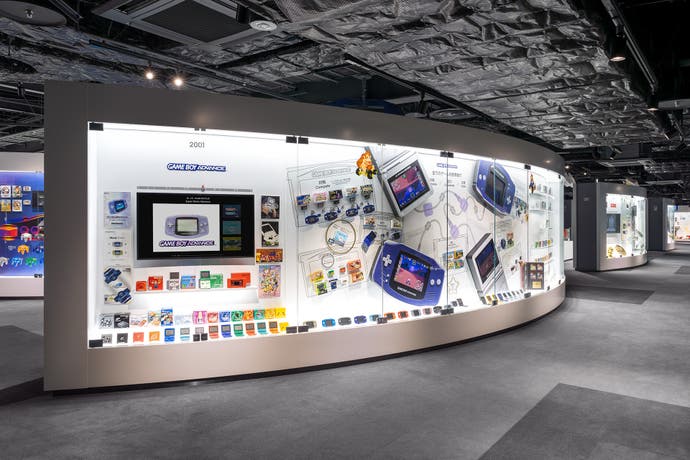
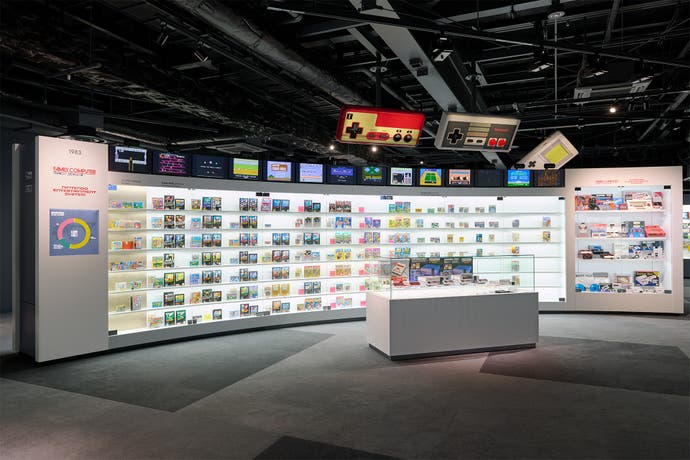
The first thing you'll likely latch onto are the giant controllers suspended from the ceiling, sitting like crowns above glass cases that are stacked with their console's respective key games, accessories, special editions and other technological feats. Everything's here - from the Famicom/NES right up to the Switch, arranged clockwise in curved, chronological segments including the Virtual Boy, Disk Writer and even some of Nintendo's arcade machines, the latter of which are tucked away in one of the corners marked 'Storage', where you'll also find some never-before-seen (and bafflingly abstract) controller prototypes that will set your mind ablaze with how they eventually evolved into their final forms. The back walls, meanwhile, are adorned with Nintendo's pre-gaming toys, board games and electronic entertainment machines, as well as celebrations of its most popular and enduring series, and collections dedicated to certain families of ideas, such as music and movement.
There's a dizzying amount of stuff to absorb and take in, but as I hinted earlier, Nintendo states upfront that what visitors experience here will be "shared with little explanation", and that as they observe the items on display, "we encourage you to form your own unique thoughts - and to share them with others". Having spent nine hours wandering round the museum this week, it's a concept that feels both refreshing, but also rich with missed opportunity. This isn't a place that finally pulls back the curtain on Nintendo's secret inner workings, nor is it the kind of exhibit that sheds new light on what you already know. In fact, Nintendo seems to be gearing it more towards complete newcomers, as the message goes on to say that "you don't need any special knowledge or familiarity with video games to make the most of your visit". In other words, the broader kind of audience welcomed during the Wii and DS era.

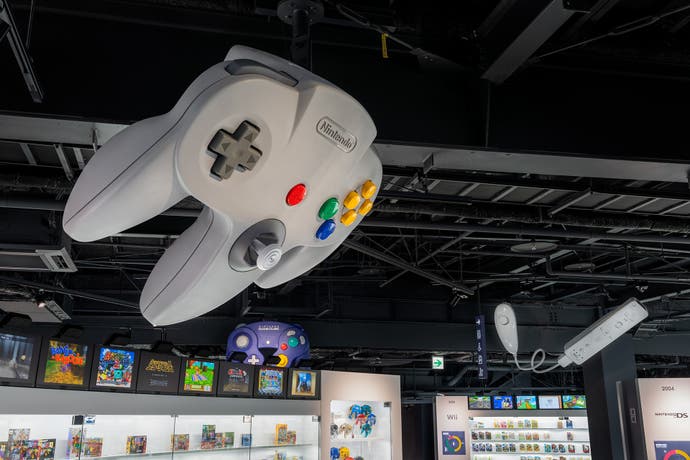
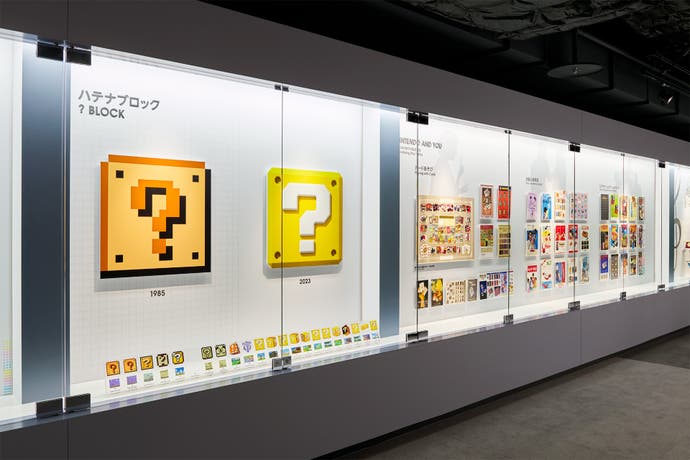
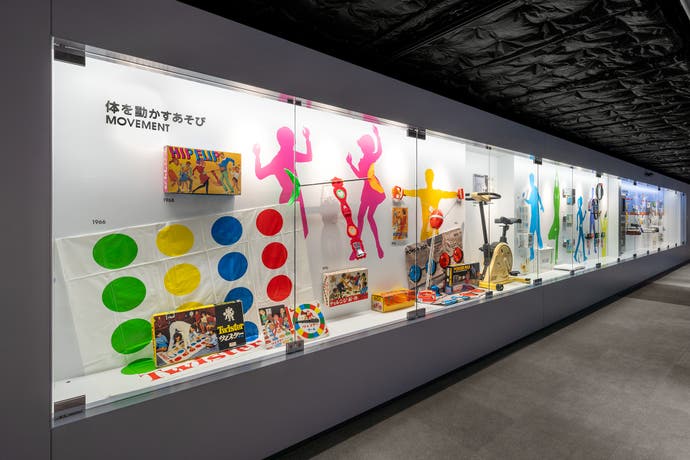
I find it hard to imagine, though, that most people making the pilgrimage out here would actually fall into this particular category, and if you truly didn't know much about Nintendo or video games at all, then this lack of explanation isn't exactly going to help you parse the company's long and varied history. It might not say so, but I'd argue that a working knowledge of Nintendo games is more or less mandatory to enjoy the museum at its fullest, and the Product Floor in particular is very much designed for visitors to coo over the games and consoles they love and recognise the most.
For instance, there's no guided path once you step foot onto the oval entrance plaza, and the way the exhibits are arranged constantly draws the eye forward in new directions. The controllers can be seen from almost everywhere, and glimpses of additional walls and exhibits through the gaps lure you further in to peel back its layers even further. You can feel a game designer's eye at work here, and even the little Game and Watch nook in the farthest corner has several Mr Game and Watches walking to the right to lead you round the supporting pillar and semi-translucent wall cordoning it off from the rest of the floor.
It entices at every step, but it also leaves you wanting more from every new segment you encounter. It's one thing to see how the company logo has evolved all the way from 1889 to present day, for example, or how the question block has changed through the years of every major Mario game, but as hanafuda cards start morphing into Disney board games, Mamaberica strollers, exercise bikes, light gun rifles and more familiar gizmos like the Ultra Hand and the Love Tester, I was desperate to know about the decisions that led to these all new incarnations of what Nintendo is and represents.
The prototype controllers left me with a million questions as well. How did a fat, orange foam frisbee with a Super Star in the middle and three buttons ever become the Wii Remote, for example? And what was Nintendo thinking when they tried making a DS that had its d-pad and buttons in between the two screens? Would the 3DS have ever existed if its predecessor's hinge had also opened like a book? These are precisely the kinds of connections Nintendo wants you to ponder and answer for yourself in this museum, but part of me still just wished to be told how one decision led to another, and what the real story was behind some of its greatest creations.
At the same time, though, there are so many instances where this muzzled silence works to spectacular effect, reminding you just why you love Nintendo in the first place (and if you don't wish to be spoiled on any of these, please skip this paragraph immediately and carry on to the next). It's the smallest details, from catching a glimpse of two Pikmin carrying a Wii Remote on the very top corner of the Wii exhibit - and another string of them all hanging together between the two palm devices of Nintendo's Love Tester, and then realising there are absolutely loads of them scuttling about the place in various poses and arrangements, and spotting as many as you can becomes its own kind of game of secret hide-and-seek. It's seeing an Animal Crossing balloon and present just casually occupying the top corner of the cafeteria, then working out the posters of fish, fossils and insects adorning the walls are all the critters you've stuffed into Blathers' own museum over the years, too. Walking up the stairs to the Hanafuda Workshop, you'll catch Excitebikers flipping and riding up the bannister handrail, along with tails of certain Pokémon peeking up from grassy nooks near the skylight above. Elsewhere, you'll glimpse Samus morph-balling through the air conditioning units, or half of Mario's bum descending a ladder in the ceiling.
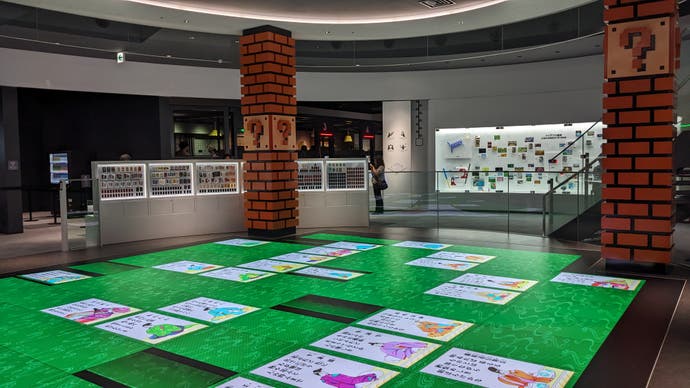
In another timeline, you can see how one might be tempted to flag these sightings up in advance and gamify them for some puny reward. But this would also ruin the fun of discovering them for yourself and feeling like the entire three buildings are alive with these characters just going about their daily business. Historically, Nintendo's always been brilliant about forging these personal dialogues with its players, anticipating the unexpected and silently winking at them through the screen as you're congratulated for discovering a warp pipe in the first Super Mario Bros, or finding a Korok seed at the peak of every mountain in Breath of the Wild - and the museum is no different, infusing it with a kind of wonder and magic that is wholly and purely Nintendo.
Nowhere is this more apparent than the second major exhibit - the Interactive Floor, which can be reached by simply descending the stairs that wrap round the Product Floor's central platform, and is entirely dedicated to the art and joy of play. Here, Nintendo's oldest and arguably strangest contraptions take centre stage, with its Ultra Hand, Ultra Machine and Love Tester all revitalised and repurposed into both co-operative and single-player experiences that have some great modern touches, as well as a gorgeous LED hanafuda floor where you must quickly find and match corresponding cards on a special smartphone device to earn points and beat the 20 other players in there with you.
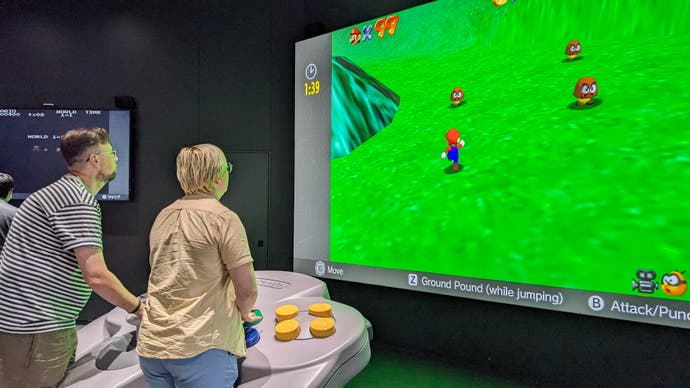

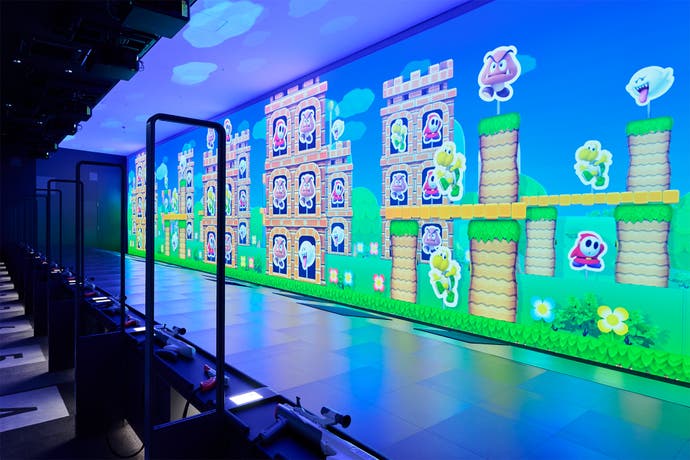
Once again, though, it's the rooms dedicated to Nintendo's game console controllers that really steal the show. The first is the enormous, wall-to-ceiling lightgun room, where 13 players can choose from the NES Zapper or the SNES' Super Scope to engage in a furious barrage of competitive Mario-themed Duck Hunt shooting. The second is a room housing jumbo Famicom, SNES, N64, Wii Remote, and Wii Balance Board controllers that all require two players to operate them in tandem as they try and complete miniature timed challenges from some of Nintendo's most recognisable games, whether it's collecting 50 coins in Super Mario 64 (a surprisingly hard feat when your C-button and jump button operator makes a complete meal of your careful joystick manoeuvrings), piloting a plane in Wii Sports Resort, or completing a race of Super Mario Kart.
I'll have more to say about the specific ins and outs of each experience in the coming days, as this is where, with a tinge of sadness, Nintendo has indeed leant in to gamifying the way you're able to experience this particular floor. Those personal, named entry cards all come loaded with ten digital coins to spend in this part of the museum, with most exhibits costing two coins, though some gobble up as many as four - and when the giant controller room asks for two coins per each controller, for example, you could arguably spend all your allotted game time on just a single room and not get to see anything else. It's the kind of scenario where you can see reluctant parents sacrificing their cards so their kids can have a good time - as you have to tap in before you can start playing - but in essence, you'll need to visit multiple times if you want to experience everything the museum has to offer here. However, with tickets currently being drawn through a lottery system, it will likely be some time before even local Kyoto residents get a chance to go again - and with Nintendo "strictly prohibit[ing] coming by taxi, private car, motorbike, or bicycle," per the museum's website, travelling here isn't as easy as it should be, either.

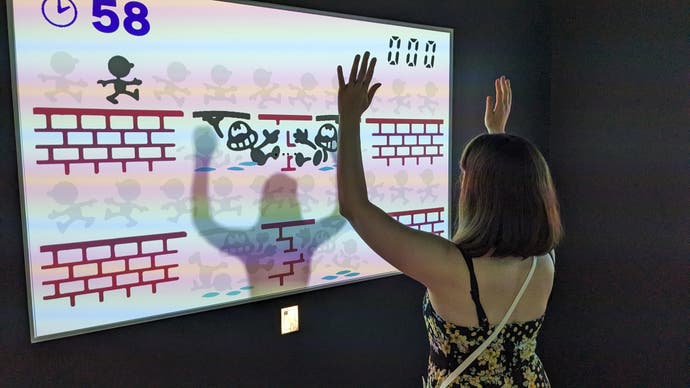

In the moment, though, you can't help but feel that same old flush of joyous delight resurface time and time again, and if you wanted to know the best way to learn about what makes Nintendo so special, it's right here in using the hardware that's allowed it to stand apart from the rest of the industry for so long. It's almost impossible to suppress that instinctive, childlike glee you feel when playing one of their games, even when you're sweating buckets waving a giant Wiimote from side to side as you try and construct an increasingly precarious tower of ice cream scoops so they're perfectly balanced on your tiny wafer cone.
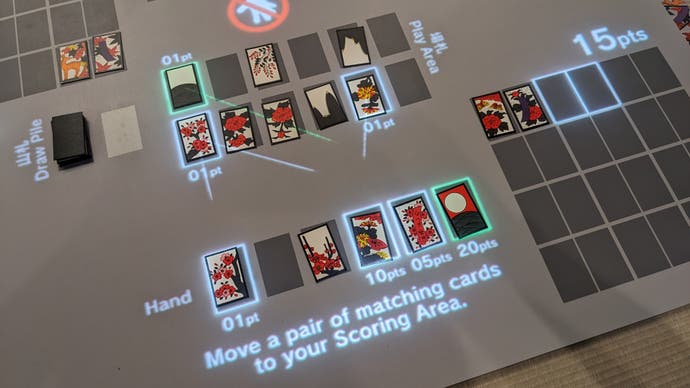
When the time came to depart, I didn't feel like I'd done an arduous day of culture - as museum visits often do. Rather, I came away feeling like I'd had a great day out, as if I'd been to a theme park without the nightmare of constant rollercoasters to endure. Of course, I was also there without having to queue to play or see any of the exhibits, which may well take the shine off things once it fully opens to the public. But when such care and attention has gone into every little detail, and its most magical nods and winks almost always draw your eyes upwards during those idle moments of waiting in line rather than keeping everything at eye-level (where adult heads inevitably get in the way of tinier minds and bodies), the Nintendo-ness of it all shines through at every stage. It's less of a museum and more a collective celebration of one of the best game makers in the world, and while you may not learn anything new during your visit, you will leave with a renewed sense of exactly why you fell in love with Nintendo in the first place, and perhaps a newfound appreciation for all the years it's been there, transporting you back to simpler and happier times.
This article is based on a press event at the Nintendo Museum, for which Nintendo provided travel and accomodation.

